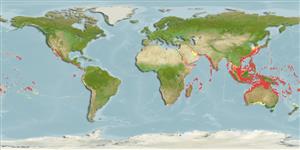Environment: milieu / climate zone / depth range / distribution range
Ecologia
marinhas associadas(os) a recifes; intervalo de profundidade 0 - 132 m (Ref. 58302). Tropical; 37°N - 38°S, 20°E - 70°W
Indo-Pacific: Red Sea and East Africa to Rapa and Easter Island, north to southern Japan, south to Australia and New Zealand (Ref. 5755). Eastern Central Pacific: Mexico to Panama, including offshore islands (Ref. 9301). First record in the Mediterranean was reported (Ref. 36327), and from several countries as of late year 2010. Often misidentified as Fistularia petimba, a reddish or brownish-orange deep-water species with bony plates along dorsal midline.
Comprimento de primeira maturação / Tamanho / Peso / Idade
Maturity: Lm 65.0 range ? - ? cm
Max length : 160 cm TL macho/indeterminado; (Ref. 9301); common length : 100.0 cm TL macho/indeterminado; (Ref. 9301)
Espinhos dorsais (total): 0; Raios dorsais (total): 14-17; Espinhos anais 0; Raios anais : 14 - 16; Vértebras: 83 - 86. Vertically flattened rather than laterally compressed body. Long whiplike tail filament. Color is green dorsally, grading to silvery white ventrally, with two blue stripes or rows of blue spots on the back. Dorsal and anal fin orange becoming transparent at base. Caudal filament white. Broadly banded at night (Ref. 48635). First four vertebrae fused (Ref. 9826). Branchiostegal rays: 5 (Ref. 36710).
Adults inhabit reef habitats to a depth of at least 128 m, except in heavy surge areas. Also found in sandy bottoms adjacent to reef areas (Ref. 36710), either solitary or in schools (Ref. 9710). Benthopelagic (Ref. 58302). Feed on small fishes, shrimps (Ref. 36327, 36710) and squids (Ref. 37816). Probably marketed fresh, salted or dried or smoked but more often reduced to fish meal (Ref. 9301).
Myers, R.F., 1991. Micronesian reef fishes. Second Ed. Coral Graphics, Barrigada, Guam. 298 p. (Ref. 1602)
Status na Lista Vermelha da UICN (Ref. 130435)
Ameaça para os humanos
Reports of ciguatera poisoning (Ref. 130160)
Uso pelos humanos
Pescarias: pouco comercial; Aquário: Espécies comerciais
Mais informação
ReferênciasAquaculturaPerfil para aquaculturaEstirpesGenéticaElectrophoresesHereditariedadeDoençasProcessamentoNutrientsConversão de massa
Ferramentas
Relatórios especiais
Baixar XML
Fontes da internet
Estimates based on models
Preferred temperature (Ref.
123201): 22 - 28.9, mean 27.5 °C (based on 1674 cells).
Índice de diversidade filogenética (Ref.
82804): PD
50 = 0.6250 [Uniqueness, from 0.5 = low to 2.0 = high].
Bayesian length-weight: a=0.00129 (0.00092 - 0.00181), b=3.00 (2.91 - 3.09), in cm total length, based on LWR estimates for this species (Ref.
93245).
Nível Trófico (Ref.
69278): 4.3 ±0.7 se; based on diet studies.
Generation time: 2.2 ( na - na) years. Estimated as median ln(3)/K based on 1
growth studies.
Resiliência (Ref.
120179): Elevada, tempo mínimo de duplicação da população menor que 15 meses (Preliminary K or Fecundity.).
Fishing Vulnerability (Ref.
59153): Moderate vulnerability (42 of 100).
Nutrients (Ref.
124155): Calcium = 32.7 [16.6, 62.5] mg/100g; Iron = 0.71 [0.38, 1.40] mg/100g; Protein = 18.7 [17.4, 19.9] %; Omega3 = 0.101 [0.050, 0.213] g/100g; Selenium = 93.7 [47.8, 203.3] μg/100g; VitaminA = 23.6 [8.1, 70.0] μg/100g; Zinc = 0.712 [0.467, 1.100] mg/100g (wet weight);
